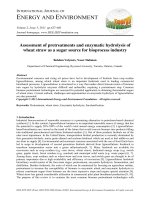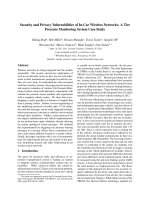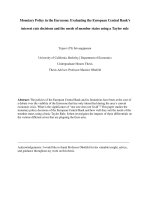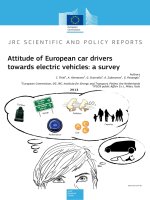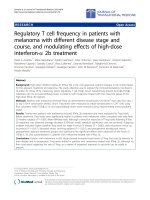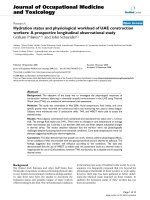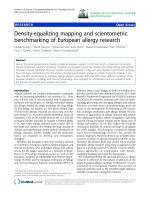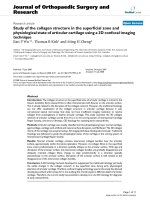Driving and parking patterns of European car drivers --- a mobility survey pptx
Bạn đang xem bản rút gọn của tài liệu. Xem và tải ngay bản đầy đủ của tài liệu tại đây (1.35 MB, 112 trang )
2 0
x x
Driving and parking patterns of
European car drivers a mobility survey.
Authors
G Pasaoglu
1
, D. Fiorello
2
, A. Martino
2
, G. Scarcella
3
, A. Alemanno
3
,
A. Zubaryeva
1
, C. Thiel
1
1
European Commission, DG JRC, Institute for Energy and Transport, Petten, the Netherlands
2
TRT Trasporti e Territorio srl, Milan, Italy
3
IPSOS public Affair S.r.l., Milan, Italy
2 0
1 2
Report EUR 25627 EN
European Commission
Joint Research Centre
Institute for Institute for Energy and Transport
Contact information
Pasaoglu Guzay, Christian Thiel
Address: Joint Research Centre - IET, P.O. Box 2, 1755 ZG Petten, The Netherlands
E-mail:
Tel.: +31 224 56 5150
E-mail:
Tel.: +31 224 56 5143
This publication is a Reference Report by the Joint Research Centre of the European Commission.
Legal Notice
Neither the European Commission nor any person acting on behalf of the Commission
is responsible for the use which might be made of this publication.
Europe Direct is a service to help you find answers to your questions about the European Union
Freephone number (*): 00 800 6 7 8 9 10 11
(*) Certain mobile telephone operators do not allow access to 00 800 numbers or these calls may be billed.
A great deal of additional information on the European Union is available on the Internet.
It can be accessed through the Europa server
JRC77079
EUR 25627 EN
ISBN 978-92-79-27738-2 (pdf)
ISBN 978-92-79-27739-9 (print)
ISSN 1831-9424 (online)
ISSN 1018-5593 (print)
doi:10.2790/7028
Luxembourg: Publications Office of the European Union, 2012
© European Union, 2012
Reproduction is authorised provided the source is acknowledged.
Printed in
The Netherlands
1
Table of Content
Executive Summary 5
1
Introduction 6
2
The direct survey 8
2.1
Definition of the reference universe 9
2.2
Sample stratification 15
2.3
The pilot phase 22
2.3.1
Feedback on the questionnaire 23
2.3.2
Feedback on the communication with the respondents 24
2.3.3
Feedback on the fill-in rules 24
2.3.4
Conclusions from the pilot phase 25
2.4
The extended fieldwork phase 25
2.4.1
Structure of the actual sample 29
2.4.2
A balance of the survey 37
2.5
Weigting and expandingthe survey results 37
2.5.1
Weighting the survey results 37
2.5.2
Expanding the survey results to population 39
2.6
Quality checks on raw survey results 40
2.6.1
Coding inconsistencies 40
2.6.2
Trip chain inconsistencies 41
2.6.3
Cleaned sample for the analysis of driving profiles 42
3
Comparisons with National Travel Surveys data 44
4
The analysis of driving behaviour 57
5
Conclusions 83
6
References 85
7
Annex 1: The final questionnaire 86
8
Annex 2: Statistical data sources 106
2
Figures
Figure 2.1 Comparison of population composition by gender in Germany. Source: derived from German NTS
(MID-2008) and EUROSTAT data, 10
Figure 2.2 Comparison of population composition by age in Germany. Source: derived from German National
Travel survey (MID-2008) and EUROSTAT 11
Figure 2.3 Comparison of population composition geographical area in Germany Source: Derived from Germany
National Travel survey (MID-2008) and EUROSTAT data 12
Figure 2.4 Comparison of population composition professional status in UK Source: Derived from UK National
Travel survey (UK NTS-2008) and EUROSTAT data 13
Figure 3.1 Comparison of number of car trips per day between the survey and the UK NTS. Source: Derived
from collected data and UK NTS 2008 data 45
Figure 3.2 Comparison of distribution of individuals by number of car trips per day between the survey and the
UK NTS. Source: Derived from collected data and UK NTS 2008 data 46
Figure 3.3 Comparison of distribution of car trips by departure time between the survey and the UK NTS.
Source: Derived from the collected data and UK NTS 2008 data 49
Figure 3.4 Comparison of average car trip distance between the survey and the UK NTS – Monday to Friday.
Source: Derived from the collected data and UK NTS 2008 data 50
Figure 3.5 Comparison of average car trip duration between the survey and the UK NTS – Monday to Friday
Source: Derived from the collected data and UK NTS 2008 data 51
Figure 3.6 Comparison of distribution of car trips by parking place between the survey and the UK NTS –
Monday to Friday Source: Derived from the collected data and UK NTS 2008 data 52
Figure 3.7 Comparison of number of car trips per day between the survey and the German MID 53
Figure 3.8 Comparison of distribution of individuals by number of car trips per day between the survey and
German MID. Source: Derived from the collected data and MID 2008 data 54
Figure 3.9 Comparison of distribution of car trips by departure time between the survey and German MID
Source: Derived from the collected data and MID 2008 data 55
Figure 3.10 Comparison of average car trip distance between the survey and the German MID. Source: Derived
from the collected data and MID 2008 data 56
Figure 3.11 Comparison of average car trip duration between the survey and the German MID. Source: Derived
from the collected data and MID 2008 data 56
Figure 4.1 Average number of car trips per day by country 57
Figure 4.2 Car trips distribution by time of the day (including return home) 62
Figure 4.3 Average daily travel distance (km) by day of the week. 63
Figure 4.4 Average trip distance (km) by trip purpose. 65
Figure 4.5 Average daily travel time (hours) by day of the week 66
Figure 4.6 Average trip duration (min) by trip purpose. 68
Figure 4.7 Average daily distribution of driving and parking time. 71
Figure 4.8 Distribution of parking places (active and inactive parking) – Monday to Friday . 72
Figure 4.9 Distribution of daily car trips by country. 72
Figure 4.10 Frequency of trip chains by purpose in the six countries. 74
Figure 4.11 Share of individuals making one or two trips on Sunday. 75
Figure 4.12 Share of two trips chains by gender. 75
Figure 4.13 Share of two trips chains for individuals aged < 26 years. 76
Figure 4.14 Share of four trips chains for individuals aged 36-45 years. 77
Figure 4.15 Share of six-trip chains for “self-employed low” individuals. 78
Figure 4.16 Share of one and two trips chains in metropolitan areas. 79
3
Figure 4.17 Share of four trips chains in rural areas. 80
Figure 4.18 Share of trips chains with a total daily driven distance < 50 km. 80
Figure 4.19 Share of trips chains with a driven time < 1 hour. Source: Derived from the collected data through
our survey 81
4
Tables
Table 2-1 Criteria Table 8
Table 2-2 Structure of the sample by country 15
Table 2-3 Stratification of the sample by gender and age group 17
Table 2-4 Stratification of the sample by geographical area 18
Table 2-5 Stratification of the sample by geographical area (continued) 19
Table 2-6 Stratification of the sample by occupational status 19
Table 2-7 Stratification of the sample by city size 19
Table 2-8 Stratification of the sample by level of education 21
Table 2-9 Statistics of the pilot fieldwork 22
Table 2-10 Duration of the extended fieldwork by country 26
Table 2-11 Invitations and completion rate by country 26
Table 2-12 Invitation waves for Germany 27
Table 2-13 Extended fieldwork statistics for Poland 28
Table 2-14 Actual sample structure by country 30
Table 2-15 Comparison of theoretical and actual sample by gender and age 30
Table 2-16 Comparison of theoretical and actual sample by geographical area 33
Table 2-17 Comparison of theoretical and actual sample by city size 35
Table 2-18 Comparison of theoretical and actual sample by education level 36
Table 2-19 Comparison of theoretical and actual sample by occupational status 36
Table 2-20 The ratios for expanding the results to the universe 40
Table 2-21 Share of corrected records during quality checks 41
Table 2-22 Share of individuals retained in the sample for the analysis of driving profiles after quality checks 43
Table 2-23 Share of trips retained in the sample for the analysis of driving profiles after quality checks 43
Table 4-1 Car trips distribution by day and purpose 60
5
Executive Summary
The development of innovative vehicles such as electric driven cars is an important
potential option for improving the sustainability of the transport sector. A significant
penetration of electric vehicles in the market is possible only if their use is compatible
with mobility patterns of individuals. For instance, the driven distance should be
compatible with the batteries range or parking patterns should enable re-charging. The
JRC-IET together with TRT and IPSOS analyzed car mobility patterns derived from direct
surveys in six European Union Member States (France, Germany, Italy, Poland, Spain and
United Kingdom). The report aims at providing some insights on how electric vehicles
could fit mobility habits of European car drivers. The analysis is based on the data
collected within six European countries by means of a sample survey. A web-based car
trips diary was filled in by on average 600 individuals in each country. The individuals
logged for 7 consecutive days their driving and parking patterns in 5 minute intervals.
For each trip several details such as departure and arrival time, distance and parking
place were registered. Socioeconomic characteristics of individuals were also collected.
The same questionnaire format was used in all countries allowing for comparability of
responses. Representativeness of the derived data was ensured by weighting and
aligning the received sample to the socio-demographic reference universe of each
member state. Survey results are statistically analyzed to describe mobility patterns. In
particular, the information on average number of car trips per day, daily travel distance,
daily travel time, trip distance, distribution of parking and driving, distribution of
parking places, trip purposes, duration of parking and many other parameters per
Member State are analyzed and presented in the report. Moreover, the analysis of the
survey data shows which share of driving patterns are compatible with the use of
electric cars with their current technical features (batteries range, re-charge time) under
alternative assumptions about the availability of re-charge facilities. Also differences and
similarities between countries and user groups are discussed.
Overall, the results of the survey provide representative driving profiles for estimating
the charging profiles of electric vehicles and many other indications on how people use
their car. The outcomes of the survey provide relevant methodological hints to develop
similar surveys in other contexts or to repeat the survey in other countries.
6
1 Introduction
Personal mobility has evolved as a distinctive trait of modernity in Europe. Allowing
citizens to move faster, farther, more safely and comfortably has been a key policy goal in
the last decades and still is. Within this process, car has played a major role. The progress
of individual mobility has been strongly interlinked with the history of mass motorization.
This history can be considered a successful one. Its success, however, has increased
personal mobility tot the extent that its undesired effects became more and more
significant. Congestion, pollution, accidents, traffic fatalities, greenhouse gas emissions can
be quoted as the major ones. The European Union has started a number of policy initiatives
to reduce the negative effects of cars while at the same time fostering the competitiveness
of the European transport sector.
In March 2011 the new Transport White Paper Roadmap to a Single European Transport
Area – Towards a Competitive and Resource-efficient Transport System (European
Commission 2011a) was published. As a very important element, this new White Paper
builds on the European objective of reducing greenhouse gas emissions (GHG) by 80 to
95% until 2050 compared to 1990 (European Commission 2011b). Transport in the White
Paper is expected to contribute to these GHG reductions by decreasing its GHG emissions
by at least 60% compared to 1990, while maintaining a competitive and resource-efficient
transport system.
One key instrument within this strategy is technology. In the automotive sector, research
aims at developing more parsimonious conventional vehicles or even (on site) zero
emissions cars. Within this effort, electric-drive vehicles (EDVs) are on the forefront of
non-conventional powertrain technology developments. Nevertheless, in some respects
they still lag behind conventional vehicles, namely for costs, driving range and refueling
speed, and further progress is needed. Thus, in the short and medium term the penetration
of EDVs in the market would depend not only on their cost, but also on how they can fit
driver needs despite the fact that their features are not the same as those of conventional
cars. At the same time, once an EDVs share in the fleet increases a certain portion of
electric power will be requested daily for vehicle charging. The amount of power requested
would depend primarily on the number of EDVs together with the time period of when this
power is requested.
Therefore, from several perspectives in order to appraise the impact of EDVs a primary
requirement is a detailed description of how cars are used. In several European countries,
national or local bodies (e.g. statistical offices, ministries for transport) carry out travel
7
surveys. Even though in some cases such surveys are detailed enough to derive car usage
profiles, in many cases only aggregate information is available. Therefore additional data is
needed. As part of a study launched by the Institute for Energy and Transport of the Joint
Research Centre of the European Commission, in the spring of 2012 a sample survey was
carried out in six European countries to investigate the driving behavior of European car
drivers. The survey was based on a web-based self-administered travel diary covering a
period of 24 hours for 7 days. From the outcome of this survey, car usage patterns can be
analyzed under various perspectives.
This report is a part of a larger study that aims at building a database of load profiles for
electric drive vehicles based on car use profiles in six countries (France, Germany, Italy,
Poland, Spain and United Kingdom). These six Member States in 2011 represented more
than 75% of the total new sales of passenger cars in EU. The study was performed by the
JRC together with TRT and Ipsos. More details on the attitude of European car drivers
towards electric vehicles as well as the revealed “ideal” composition of such a vehicle with
respective potential policy implications can be found in the report on “Attitude of
European car drivers towards electric vehicles: a survey” (Thiel et al, 2012).
This report presents driving habits drawn from the survey results which are more
significant in relation to the subsequent study activities on the use of electric vehicles. The
structure of the report is the following. Section 2 describes the methodological aspects of
the survey, providing details on the sample, the pilot phase, the extended fieldwork phase
and the quality checks on results. In section 3, a comparison between the outcome of the
survey and the national travel surveys data of UK and Germany is conducted in order to
validate the results. Section 4 provides some descriptive statistics about the derived car
usage information by employing the data obtained through the survey.The full text of the
questionnaire used in the survey as well as the texts of the communications with the
panelists are provided in the annex.
8
2 The direct survey
Before the direct survey, we conducted a meta-analysis of National Travel Surveys (NTS) of
the United Kingdom, Germany, France, Spain and Italy to determine their sufficiency for
analysing the potential impacts of EDVs on the European electricity system. Throughout
the meta-analysis, we assessed the national travel surveys against the presence/absence
and completeness of information regarding the criteria table illustrated in Table 2-1
Table 2-1 Criteria Table
Description of data Requirement
Type Trip diaries
Aggregation Individual data
Surveyed period 7 days - 24 hours
Parking details Duration and place
Individual details Information on
socio-economic
features
Vehicle details Vehicle size and age
Living Area Segmentation in
rural and urban
area
Geographical
Coverage
Entire country
The conducted analysis reveals that only the UK National Survey matches the data needs in
order to conduct a comprehensive scenario analysis for the EDV recharge profiles.
On the other hand, the German NTS has a similar level of detail as the UK NTS but does not
include each individual’s trips for an entire week and misses details for parking (where and
how long cars remain parked during the day). The remaining national travel surveys
present the data only at aggregated level. This kind of data can be used to identify different
travel behaviors across different conditions (e.g. for different population groups or
different areas) but is not helpful to derive representative driving patterns for cars
Due to this reason and in order to ensure comparability across Member States, we
conducted our own mobility surveys for aforementioned member states. The remaining
part of section 2 presents a detailed description of how the direct survey was performed in
the six European Member States.
9
2.1 Definition of the reference universe
The survey generated a wide-ranging debate as to how to identify the reference universe
for the study. Since the task was to carry out a survey of the car-driving population, the
ideal universe of reference would have been a part of the population holding a driving
license and regularly driving a car. However, the socio-demographic characteristics of this
car-driving population are basically not known, due to the lack of detailed data
(furthermore, existing data is not uniformly available in all the countries covered by the
study). Generally available information is the socio-demographic composition of the
population in age.
From the data of the NTS in the UK and Germany, some comparisons between the
composition of the overall population and of the population of car drivers can be made.
Comparisons are summarized in the figures below (Figure 2.1 to Figure 2.4).They show
that even if there are some differences, the profile of the two populations is reasonably
similar.
Therefore, it was assumed that the profile of people holding a driving license and driving a
car does not significantly differ from the universe of the people across age profiles. This
way the population over 18 years of age could be considered as the best possible
approximation to that ideal universe and taken as the operating reference universe for the
survey, i.e. the basis for constructing the theoretical sample in terms of quotas. This
decision was considered as the best possible balance between the knowledgeable universe
and the ideal universe (which cannot be known in advance).
10
0%
10%
20%
30%
40%
50%
60%
70%
80%
90%
100%
Population in age Car drivers
Female
Male
Figure 2.1 Comparison of population composition by gender in Germany. Source: derived from German
NTS (MID-2008) and EUROSTAT data1,2
1
Population in age is 18 years or older
2
For detailed Statistical data sources see Annex II.
11
0.0%
5.0%
10.0%
15.0%
20.0%
25.0%
30.0%
35.0%
40.0%
18-24 years 25-44 years 45-59 years 60-64 years > 64 years
Population Car drivers
Figure 2.2 Comparison of population composition by age in Germany. Source: derived from German
National Travel survey (MID-2008) and EUROSTAT3
3
For detailed Eurostat sources see Annex II.
12
Figure 2.3 Comparison of population composition geographical area in Germany Source: Derived from
Germany National Travel survey (MID-2008) and EUROSTAT data4
4
For detailed Eurostat sources see Annex II
0.0%
5.0%
10.0%
15.0%
20.0%
25.0%
30.0%
< 2 ths
inhab.
2
-
5 ths
inhabit.
5
-
20 ths
inhabit.
20
-
50 ths
inhabit.
50
-
100 ths
inhabit.
100
-
500
ths
inhabit.
500 ths
inhabit.
Population in age
Car drivers
13
0%
10%
20%
30%
40%
50%
60%
70%
80%
90%
100%
Population in age Car drivers
Unemployed
Employed
Figure 2.4 Comparison of population composition professional status in UK Source: Derived from UK
National Travel survey (UK NTS-2008) and EUROSTAT data5
The initial construction of the theoretical sample to be used for the main survey took the
following elements into account:
The size of the total samples required, i.e., 600 cases for each country.
The number of interviews carried out during the pilot phase (different from country
to country, see section 2.2).
The number of cases to be used for oversampling (also different from country to
country, depending on the number of cases obtained during the pilot).
Basically 500 individuals were considered as sufficient to represent the national sample.
The total sample size of 600 was reached considering the interviews completed during the
pilot phase and the additional individuals for oversampling frequent car users. The sample
size of 600 individuals for each country was chosen according to the budget available for
the study. When a sample survey is organized for estimating a specific variable (e.g. the
proportion of population holding a certain preference) the definition of the sample size can
be based on the desired confidence interval for the estimator. This survey was aimed at
collecting a number of different items (e.g. the share of individuals making more trips per
day, the share of individuals parking on kerbside and so forth) describing the driving
habits of the individuals. Therefore the sample size can be hardly based on considerations
5
For detailed Eurostat sources see Annex II
14
regarding the confidence interval of estimations. Notwithstanding, if one think of the
survey as focused on given indicators, an indicative confidence interval for the estimates
provided by the sample size of 600 individuals can be identified.
Namely, if the target variable is e.g. the proportion of drivers making n trips per day,
assuming that this proportion is totally unknown a priori (and so in the worst case) a
random sample of 600 individuals can provide the estimation of this proportion with a
confidence interval of 0.04 in the 95 of the cases. This means that if the estimated
proportion is 20%, the confidence interval will be 16-24%. Since the sample is stratified
rather than a pure random one, the interval can be narrower.
Instead, if we consider the estimation of an average value (e.g. the average number of trips
per day), assume that the distribution of this variable in the population is a Normal with a
standard deviation of 2.4, a random sample of 600 individuals provides the estimation of
the average number of trips per day with a confidence interval of ± 0.2 trips in the 95% of
the cases. Again, since the sample is stratified, the interval can be reduced. However, the
distribution of trips is not symmetrical so the interval indicated is only indicative.
In each country, it was decided to oversample the subjects who used a car often (every day
or nearly every day) as they are the most relevant to provide the required information on
driving profiles. Car use frequency was ascertained during the interview, by means of a
filtering question.
The following table summarizes the structure of the sample in each country.
15
Table 2-2 Structure of the sample by country
France Germany Italy Poland Spain UK
Total interviews to be
conducted
600 600 600 600 600 600
Pilot stage (completed)
43 16 25 11 17 17
To be conducted during
main survey
557 584 575 589 583 583
National representative
sample
500 500 500 500 500 500
Oversampling 57 84 75 89 83 83
2.2 Sample stratification
Quota samples were set for the 500 individuals of the national representative sample. For
the oversample no identification criteria were set, other than regular car use on a daily
basis, because the unique purpose of the oversample was to increase the number of
frequent car users.
The following stratification criteria were used in each country:
Gender by age group (2 methods * 3 age ranges)
Geographical area (with a definition which is slightly different from country to
country depending on the geographic composition of the country)
City size (with a definition which is slightly different from country to country
depending on the geographic composition of the country)
Level of education (degree/no degree)
Occupational status (in work vs. not in work)
The stratification variables related to the level of education and occupational status were
set as “soft quotas”, that is, a margin of oscillation was allowed around the predefined
strata size required.
In setting the theoretical sample, it was further decided to opt for non-proportional
distribution in relation to the universe, for the demographic variables of gender by age
groups, level of education, and occupational status. The reason was to facilitate the
interpretation of the data (i.e. by increasing the sample size of strata which otherwise
would be very small) and on the other it maintained homogeneity between the various
countries, enabling them to be compared. In relation to the education and employment
status there was another reason for a non-proportional distribution of the sample. i.e. that
the proportions of the knowledgeable universe (based on the available official sources)
16
underestimate the share of occupied and educated people because they include underage
inhabitants.
The size of the strata in the population was estimated based on several sources. As far as
possible the same source (namely EUROSTAT) was used across countries for the sake of
homogeneity and comparability. However, in many cases EUROSTAT statistics are not
detailed enough for the purposes of the estimation and national sources were used instead.
For the full references on Eurostat and national statistics refer to Annex 2.
The following tables set out the stratification of the main sample in each country in
comparison to the composition of the population.
17
Table 2-3 Stratification of the sample by gender and age group
Male Female Total
Sample Sample
share
Pop
share
Sample Sample
share
Pop
share
Sample Sample
share
Pop
share
France
18-34 80
16.0%
13.6%
80
16.0%
13.5%
160
32.0%
27.1%
35-54 95
19.0%
17.2%
90
18.0%
17.6%
185
37.0%
34.8%
55+ 78
15.6%
16.9%
77
15.4%
21.2%
155
31.0%
38.1%
Total 253
51.0%
47.7%
247
49.0%
52.3%
500
100.0%
100.0%
Germany
18-34 78
15.6%
12.3%
75
15.0%
11.9%
153
31.0%
24.2%
35-54 95
19.0%
18.5%
90
18.0%
17.9%
185
37.0%
36.4%
55+ 82
16.4%
17.8%
80
16.0%
21.6%
162
32.0%
39.4%
Total 255
51.0%
48.6%
245
49.0%
51.4%
500
100.0%
100.0%
Italy
18-34 75
15.0%
12.0%
73
14.6
11.6
148
29.6
23.6
35-54 89
17.8%
18.4%
92
18.4
18.6
181
36.2
37.0
55+ 88
17.6%
17.6%
83
16.6
21.8
171
34.2
39.4
Total 252
50.4%
48.0%
248
49.6
52.0
500
100.0
100.0
Poland
18-34 88
17.6%
16.8%
95
19.0%
16.2%
183
36.6%
33.0%
35-54 90
18.0%
16.7%
92
18.4%
16.9%
182
36.4%
33.6%
55+ 75
15.0%
14.1%
60
12.0%
19.3%
135
27.0%
33.4%
Total 253
50.6%
47.6%
247
49.4%
52.4%
500
100.0%
100.0%
Spain
18-34 82
16.4%
14.3%
81
16.2%
13.7%
163
32.6%
28.0%
35-54 87
17.4%
19.1%
90
18.0%
18.7%
177
35.4%
37.8%
55+ 81
16.2%
15.4%
79
15.8%
18.8%
160
32.0%
34.2%
Total 250
50.0%
48.8%
250
50.0%
51.2%
500
100.0%
100.0%
UK
18-34 82
16.4%
14.7%
81
16.2%
14.2%
163
32.6%
28.9%
35-54 90
18.0%
17.4%
88
17.6%
17.8%
178
35.6%
35.2%
55+ 79
15.8%
16.6%
80
16.0%
19.3%
159
31.8%
35.9%
Total 251
50.2%
48.7%
249
49.8%
51.3%
500
100.0%
100.0%
Source: Derived from EUROSTAT data
18
Table 2-4 Stratification of the sample by geographical area
Country/Region Sample Sample Share Pop share
France
Île-de-France 94
18.8%
18.8%
South-west and West 123
24.5%
24.5%
Centre-east & Mediterranean 122
24.6%
24.6%
North: Pas de Calais and East 75
15.0%
15.0%
Paris Basin 86
17.1%
17.1%
Total 500
100.0%
100.0%
Germany
Hamburg, Bremen, Schleswig-Holstein, Lower Saxony 81
16.1%
16.1%
North Rhine-Westphalia 109
21.9%
21.9%
Hesse, Rhineland-Palatinate, Saarland 68
13.6%
13.6%
Baden-Württemberg 66
13.1%
13.1%
Bavaria 76
15.3%
15.3%
Berlin 21
4.2%
4.2%
Mecklenburg-Western Pomerania, Brandenburg, Saxony-Anhalt+Thuringia,
Saxony
79
15.8%
15.8%
Total 500
100.0%
100.0%
Italy
North West 133
26.6%
26.6%
North East 96
19.2%
19.2%
Centre 98
19.7%
19.7%
South & Islands 173
34.5%
34.5%
Total 500
100.0%
100.0%
Poland
Centralny 102
20.3%
20.3%
Poludniowy 104
20.8%
20.8%
Wschodni 88
17.7%
17.7%
Pólnocno-Zachodni 80
16.0%
16.0%
Poludniowo-Zachodni 51
10.2%
10.2%
Pólnocny 75
15.0%
15.0%
Total 500
100.0%
100.0%
Spain
North-west and North-east 187
37.4%
37.4%
Madrid and Centre 130
26.0%
26.0%
East 70
14.0%
14.0%
South and Canaries 113
22.6%
22.6%
Total 500
100.0%
100.0%
(continue)
19
Table 2-5 Stratification of the sample by geographical area (continued)
Country/Region Sample Sample
Share
Pop
share
UK
Greater London 63
12.6%
12.6%
Midlands 80
16.0%
16.0%
South East & East of England 115
23.0%
23.0%
Scotland + Northern Ireland 56
11.3%
11.3%
North West 56
11.2%
11.2%
North East & Yorkshire 63
12.6%
12.6%
South West & Wales 67
13.3%
13.3%
Total 500
100.0%
100.0%
Table 2-6 Stratification of the sample by occupational status
Sample
Sample
share
Pop
share
France
In work 315
63.0%
48.7%
Not in work 185
37.0%
51.3%
Total 500
100.0%
100.0%
Germany
In work 312
62.5%
54.7%
Not in work 188
37.5%
45.3%
Total 500
100.0%
100.0%
Italy
In work 300
60.0%
43.3%
Not in work 200
40.0%
56.7%
Total 500
100.0%
100.0%
Poland
In work 310
62.0%
48.3%
Not in work 190
38.0%
51.7%
Total 500
100.0%
100.0%
Spain
In work
300
60.0%
45.6%
Not in work 200
40.0%
54.4%
Total 500
100.0%
100.0%
UK
In work 310
62.0%
54.6%
Not in work 190
38.0%
45.4%
Total 500
100.0%
100.0%
Source: Derived from EUROSTAT data. Note: soft quotas
Table 2-7 Stratification of the sample by city size
20
Country/Size Sample
Sample
Share
Pop
share
France
<20.000 inhabitants 217
43.4%
43.4%
20-199.999 inhabitants 93
18.6%
18.6%
200.000 + inhabitants 190
38.0%
38.0%
Total 500
100.0%
100.0%
Germany
up to 20.000 inhabitants 149
29.7%
29.7%
20.001 - 100.000 inhabitants 74
14.8%
14.8%
100.001 - 500.000 inhabitants 86
17.3%
17.3%
>500.000 inhabitants 191
38.2%
38.2%
Total 500
100.0%
100.0%
Italy
up to 10.000 inhabitants 155
31.0%
31.0%
10-30.000 inhabitants 121
24.3%
24.3%
30-100.000 inhabitants 106
21.2%
21.2%
>100.000 inhabitants 118
23.5%
23.5%
Total 500
100.0%
100.0%
Poland
Rural areas 195
39.0%
39.0%
Towns up to 20.000 inhabitants 65
12.9%
12.9%
Towns from 20.001 to 100.000 inh. 97
19.4%
19.4%
Towns >100.000 inhabitants 143
28.7%
28.7%
Total 500
100.0%
100.0%
Spain
up to 20.000 inhabitants 159
32.0%
32.0%
20-100.000 inhabitants 142
28.3%
28.3%
>100.000 inhabitants 199
39.7%
39.7%
Total 500
100.0%
100.0%
UK
Up to 100.000 inhabitants 77
15.5%
15.5%
100-500.000 inhabitants 385
77.0%
77.0%
>500.000 inhabitants 38
7.5%
7.5%
Total 500
100.0%
100.0%
21
Table 2-8 Stratification of the sample by level of education
Sample
Sample
share
Pop
share
France
Graduates 200
40.0%
26.3%
Non-graduates 300
60.0%
73.7%
Total 500
100.0%
100.0%
Germany
Graduates 200
40.0%
22.6%
Non-graduates 300
60.0%
77.4%
Total 500
100.0%
100.0%
Italy
Graduates 200
40.0%
13.0%
Non-graduates 300
60.0%
87.0%
Total 500
100.0%
100.0%
Poland
Graduates 200
40.0%
19.8%
Non-graduates 300
60.0%
80.2%
Total 500
100.0%
100.0%
Spain
Graduates 200
40.0%
28.1%
Non-graduates 300
60.0%
71.9%
Total 500
100.0%
100.0%
UK
Graduates 200
40.0%
31.5%
Non-graduates 300
60.0%
68.5%
Total 500
100.0%
100.0%
Source: Derived from EUROSTAT data. Note: soft quotas
22
2.3 The pilot phase
The pilot phase took place in the period 9th February – 9th March 2012. Originally a
shorter period was envisaged, but given the response rates it took more time to get a
sufficient number of interviews. The statistics of the pilot fieldwork are reported in Table
2-9
Table 2-9 Statistics of the pilot fieldwork
France Germany Italy Poland Spain UK
Completes 43 16 25 11 17 17
Incompletes 274 59 73 64 67 75
Eliminated by screening 259 78 35 37 71 48
Screened out (diary rules not respected) 110 17 43 26 52 13
Total entries 686
170 176
138
207 153
Invitations 1249 228 442 428 487 235
Response rate
1
55% 75% 40% 32% 43% 65%
Incidence
2
14% 17% 42% 23% 19% 26%
Dropped out (incorrect diary keeping)
3
26% 18% 30% 26% 38% 12%
Expected completion rate
4
3.4% 7.0% 5.7% 2.6% 3.5% 7.2%
1 = Total entries / invitations
2 = Completes / (complete+eliminated by screening)
3 = Screened out (diary rules not respected) / (Complete +Incomplete + Screened out (diary rules not respected)
4 = Completes / invitations sent
In the four weeks of the pilot phase, a variable number of completed interviews were
obtained in the four countries, ranging from the 11 interviews of Poland to the 43 of
France.
The response rate was also quite variable; it was higher for UK and Germany and lower
especially for Poland. Given the target of valid interviews, other things being equal more
invitations are needed where the response rate is low.
The other things are especially interpreted by the incidence, i.e., the share of completed
questionnaires, Here the best result was obtained in Italy, while Spain, Germany and
France only a relatively low number of panellists was able or available to complete the
questionnaire after having accepted to fill it in.
One reason for not completing the questionnaire was that respondents were screened out
by the system if they did not fill in the questionnaire in the system within 2 days. This
happened more frequently in Italy and Spain and less frequently in Germany and UK.
23
In summary, the expected completion rate was a first key outcome of the pilot phase as it
gave an estimation of how many invitations would be needed to get all the required
interviews. This rate was generally low, especially in Spain, France and Poland, while it was
larger in Germany and UK but anyway well below 10%.
It should be considered that in the number of questionnaires in the pilot phase also some
test respondents were included. Test respondents were selected within the TRT, IPSOS and
JRC-IET staff. The questionnaires of the test respondents were NOT included in the final
sample, while the other responses obtained in the pilot phase were included to reach the
total number of 600 cases in each country.
If the estimate of the completion rate was one key result of the pilot phase, the feedback
received about aspects like the format of the questions, the communication with the
respondents, the filling in rules were also very important for finalizing the design for the
extended fieldwork phase. These aspects are discussed below.
2.3.1 Feedback on the questionnaire
The feed-back on the questionnaire includes different aspects: the functioning of the web-
questionnaire, the wording of the questions, the definition used in the questions.
As far as the wording and the definition are concerned, we received a number of requests
for changes to the questionnaire. Such requests, especially concerning the translation in
the original languages were used to refine the questionnaires for the extended survey. One
missing category in the classification of cars by age was detected. A pop up explaining how
to describe the parking place (and inviting the respondent to take a few seconds to read
each explanation) was added to the questionnaire to reduce misunderstanding on this
item.
As for the functioning of the web questionnaires the main issues were:
some respondents thought the whole questionnaire had to be submitted at once
(whereas it was to be sent as three separate parts at three different times),
some respondents failed to print out the table on which departure time, arrival
time, and distance travelled were to be recorded,
In some cases the third section was not displayed (because those particular
respondents had been screened out before they finished the 7-day diary)
Another issue raised was that some respondents could not access the questionnaire
when they made a trip late in the evening, especially if they arrived home after
midnight.
These problems were addressed as part of the communication with the panellists and of
the filling in rules.
